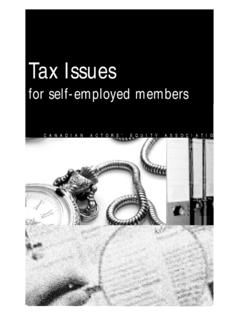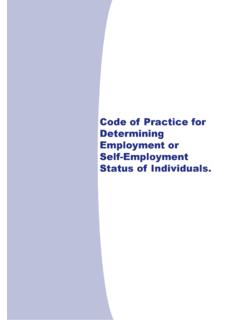Transcription of POLICY BRIEF ON THE FUTURE OF WORK The …
1 POLICY BRIEF ON THE FUTURE OF WORK The FUTURE of Social Protection: What works for non-standard workers? POLICY BRIEF ON THE FUTURE OF WORK - The FUTURE Social Protection: What works for non-standard workers? OECD 2018 1 May 2018 Key facts about the FUTURE of social protection in OECD countries Non-standard work is not a marginal phenomenon: one in six workers is self - employed across the OECD on average, and a further one in eight employees is on a temporary contract. The number of online platform workers, while still small overall, is growing rapidly.
2 Social protection of non-standard workers is often patchy, especially for the self - employed . POLICY issues include: who should be liable for their employer contributions? How should means-tests take account of fluctuating earnings? And how can involuntary loss of work be established if there is no employer? Several countries have opted for voluntary schemes to extend social protection coverage to non-standard workers. But these schemes risk adverse selection of members: the workers with the highest risks have the biggest incentives to join the scheme making risk pooling difficult.
3 Unequal social protection can introduce bias: firms may shift work to workers who are less protected due to lower cost. Including some employment forms in the general social protection system can limit the rise of non-standard employment, as seen in Italy and Austria. Rapid and deep technological changes driven by the digital revolution, together with globalisation and demographic changes, are creating many new job opportunities but also new challenges. In particular, these transformations are contributing to the rise in non-standard forms of employment self -employment, temporary work, and independent contracting.
4 It has become easier and cheaper to offer and find work online. Digitalisation lowers transaction costs, allowing firms to outsource more activities, and blurring the boundaries of the firm. Jobs for digital platforms gig jobs have grown spectacularly in recent years, although they still account for a very small share of workers in OECD countries ( Katz and Krueger (2016)). Non-standard forms of employment offer valuable flexibility to some workers, and reduce barriers to employment to those excluded from the labour market.
5 They can also facilitate the integration of services in the cash economy into the formal economy, as transactions are recorded by the platform (OECD, 2018). But workers are also exposed to new risks: for example, gig or crowd workers are given contracts for specific tasks, and thus have little if any job security. Given their formal classification as self - employed or employees but with very short-duration contracts, they also tend to have less access to social protection.
6 For firms, in turn, there are benefits from paying lower or no social contributions, fewer employment regulations, and task-specific expenditures rather than permanent salaries. Rising numbers of non-standard workers may also erode the effectiveness of social protection systems. If taxes and social contributions are payable only for some categories of workers, firms have an incentive to shift work to workers who are less protected and less expensive.
7 Non-standard work is not a new phenomenon: on average in the OECD, 16% of all workers are self - employed and a further 13% of employees are on temporary employment contracts; self -employment has actually decreased slightly over the past 20 years (although this development was uneven across countries, Figure 1). But if non-standard work increases due to globalisation and digitalisation, closing gaps in social protection will become more urgent.
8 Today, only 6 out of 28 European Union member states insure the self - employed in the same way as standard employees (Spasova et al., 2017). 2 POLICY BRIEF ON THE FUTURE OF WORK - The FUTURE Social Protection: What works for non-standard workers? OECD 2018 Figure 1. Non-standard work is widespread in some countries Temporary workers as a share of dependent employment, in percent self -employment as a share of total employment, in percent Note: There are no data on temporary employment for Israel, Mexico, New Zealand or the United States, no data on self -employment for Iceland, Luxembourg and Estonia (after 2000); no data on France before 2003 and Switzerland before 2005.
9 Data on self -employment for Turkey and the UK refer to 2000, for Spain to 1998, for Austria to 1999, for the Slovak Republic to 2000 and 2015, and for Latvia to 1998 and 2014. Data is ordered according to the share of self -employment in total employment in 2016 in descending order. Source: OECD (2017), Labour Force Statistics: Summary tables and OECD Employment and Labour Market Statistics (database). The forthcoming OECD publication The FUTURE of Social Protection: What works for non-standard wo rkers?
10 Looks at POLICY examples from seven OECD countries and draws lessons on what does and does not work. This BRIEF highlights key insights from these case studies. Why are non-standard workers often not covered by social protection? Social protection systems were designed with the model of a single, stable, full-time employment relationship in mind. Part-time and temporary workers are typically insured in the same way as standard workers as long as they meet the income and minimum contribution requirements.


















